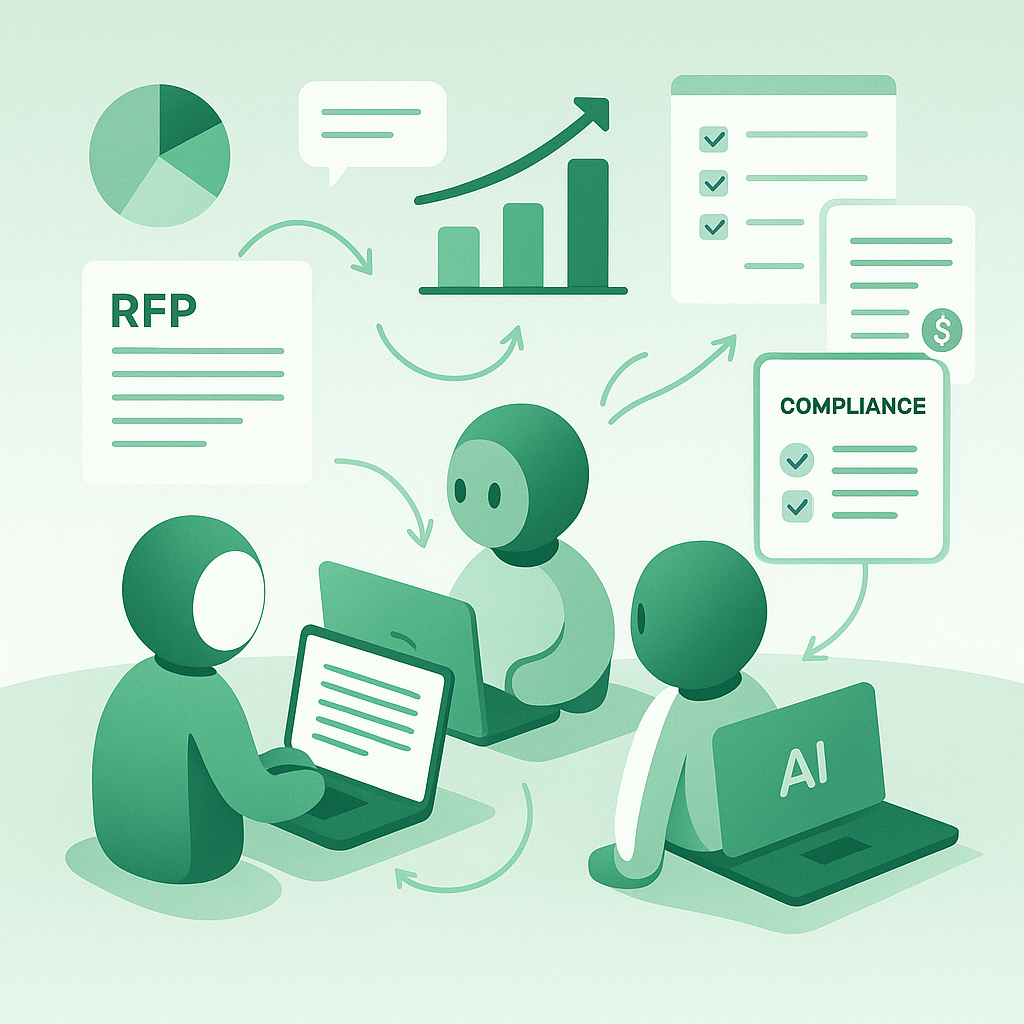Key Benefits of Agentic Workflows Explained
Agentic workflows are transforming how businesses handle complex document tasks like RFP responses, financial reporting, and compliance. By leveraging AI agents, these workflows automate repetitive processes, enhance accuracy, and reduce manual overhead.
They integrate with document automation tools to streamline creation, formatting, and validation, ensuring documents are produced faster and with fewer errors. No-code platforms further democratize access, allowing non-technical users to build and manage these systems.
In this article, we explore how agentic workflows are driving efficiency, standardization, and scalability in modern document-heavy operations.
Want an easy breakdown on the meaning of agentic AI? Check out our 5-Minute Starter Kit.
Introduction to Agentic Workflows
Agentic workflows are the backbone of modern AI-driven automation. They use autonomous AI agents to complete complex, rule-based tasks, like generating board reports or assembling RFPs, without constant human input.
These workflows are flexible, integrating with existing systems and adapting in real time to data changes or business logic. With components like document templates, AI agents, and no-code builders, companies can launch efficient workflows faster than ever. As of 2025, over 72% of organizations report actively using agentic AI systems, demonstrating the maturity and relevance of autonomous document workflows.
More than a productivity boost, agentic workflows offer a smarter way to tackle high-stakes documentation at scale.
Definition and Overview
At their core, agentic workflows empower software agents to act autonomously and intelligently. These agents don’t just execute commands, they make micro-decisions to improve task quality over time.
Key features include:
- Autonomy: Agents perform tasks independently
- Adaptability: Systems adjust based on context and input
- Efficiency: Reduces cycle time and labor effort
This makes agentic workflows a perfect match for areas like financial analysis, compliance reporting, and funding decks, where consistency, logic, and timeliness are critical.
Importance in Today’s Digital Landscape
As documentation becomes more complex and time-sensitive, businesses need systems that adapt and scale. Agentic workflows offer exactly that: a way to respond faster, work smarter, and free teams from routine work.
Enterprise adoption of agentic AI has grown by 450% since 2022, signaling a strategic pivot toward more autonomous operations. Businesses that invest in these systems today gain a real-time edge over competitors still stuck in manual workflows.
Key Benefits of Agentic Workflows
When applied to document-heavy workflows, agentic AI brings both strategic and tactical advantages. It’s not just about saving time, it’s about building more reliable, responsive operations.
Enhanced Efficiency
AI agents reduce cycle times on critical documents. For example, a financial report that once took days to finalize can now be generated in hours, with automated data pulling, formatting, and insights built-in.
When applied to document-heavy workflows like RFPs or quarterly reports, agentic AI dramatically improves turnaround time and productivity. This isn’t just a qualitative benefit, it’s quantifiable. Every $1 invested in AI generates an average of $4.90 in business value, according to IDC projections. That multiplier effect makes AI-enhanced workflows a high-ROI investment, especially in teams handling recurring, complex documentation.
Automation of Repetitive Tasks
Routine tasks like updating charts, formatting reports, or checking document structure are automated. This frees up time for review and strategic editing, instead of grunt work.
Benefits include:
- Fewer manual errors
- Faster turnaround times
- Greater process consistency
Improved Accuracy and Consistency
AI agents follow strict logic and templates, reducing the risk of formatting inconsistencies or outdated content. This is especially valuable for regulated documents like investor decks or compliance reports.
Scalability and Flexibility
Whether you're managing 10 or 1,000 documents, agentic workflows scale without adding complexity. As business needs evolve, workflows can be adjusted in minutes, not weeks.
You can:
- Tailor logic to department needs
- Support multi-language versions
- Adjust for new compliance rules
Multi-Agent Interactions
In complex document flows, multiple AI agents often work in tandem. One agent gathers data, another drafts content, and a third reviews for compliance, mirroring real-world workflows but with machine-level precision.
AI Agentic Workflows: Leveraging AI in Workflows
AI agentic workflows combine automation with decision-making intelligence. These agents don’t just follow instructions, they evaluate inputs, adjust logic, and optimize outputs in real-time.
Benefits include:
- Smart data handling
- Structured document logic
- Faster, higher-quality deliverables
Overview of AI Agents
AI agents are software entities programmed to complete tasks like formatting, validating, or drafting documents. They process inputs, make decisions, and improve outcomes over time.
For example, in an RFP workflow, one agent might analyze the requirements while another assembles relevant past answers and formats them into a compliant document.
The Role of AI in Document Automation
AI takes the pain out of document generation. Instead of starting from scratch each time, agents pull structured data, fill templates, and ensure all necessary sections are complete.
AI can:
- Automate narrative generation
- Check for data completeness
- Maintain brand and formatting standards
AI Document Generators
These tools transform how teams produce reports, pitch decks, and compliance documents. Rather than building content manually, agents pull from databases and apply logic to generate a complete first draft.
Benefits:
- Saves hours per document
- Reduces human editing needs
- Ensures consistent tone and structure
Document Templates and Generation
Templates become smarter with agentic AI. Pre-defined formats allow teams to generate documents at scale, while AI ensures every section is populated accurately.
Advantages:
- Predictable quality
- Customizable content blocks
- Instant updates across multiple docs
Examples of Successful Agentic Workflows
Use Case 1: RFP Response Automation
Responding to RFPs requires speed, precision, and consistency. Agentic workflows streamline this by:
- Extracting relevant sections from previous proposals
- Auto-filling company data
- Ensuring formatting compliance
AI agents reduce human effort while increasing submission quality, making it easier to respond quickly and win more bids.
Use Case 2: Financial Analysis and Reporting
Recurring financial documents, like board updates or monthly forecasts, are ripe for automation. Agentic workflows can pull data from finance systems, format key metrics, and generate analysis summaries automatically. In one enterprise use case, agentic ERP agents reduced processing time by 40% and cut error rates by 94%, making financial reporting faster, more reliable, and far less dependent on manual review.
This leads to faster decision-making and fewer last-minute errors before deadlines.
Use Case 3: Compliance and Regulatory Reports
Regulated industries require strict documentation. Agentic workflows ensure every compliance report is complete, version-controlled, and audit-ready.
AI agents can flag outdated sections, enforce checklist logic, and output PDF-ready documents that meet industry standards, reducing risk and increasing confidence.
Building Agentic Workflows with No Code App Builders
Building these workflows used to require developers, now anyone can do it. No-code platforms empower teams to design, deploy, and iterate on workflows through drag-and-drop interfaces.
This opens the door for operations, finance, and legal teams to build the tools they need, without relying on engineering.
Introduction to No Code Solutions
No code tools remove the technical barrier to automation. Teams can launch an RFP builder, a reporting workflow, or a compliance checklist without writing code.
It democratizes innovation and accelerates deployment timelines.
With tools like Thinkeo, teams can go from idea to working document workflow in minutes, configuring templates, connecting data, and orchestrating AI agents through a visual interface. This opens up automation to business users, not just developers.

Benefits of No Code for Agentic Workflows
No-code tools enable fast iteration, low-cost development, and user-driven customization. Benefits include:
- Faster rollout
- More responsive systems
- Greater ownership by business teams
Conclusion
Agentic workflows powered by AI are redefining how companies handle documents, from proposals to reports to regulatory files. They reduce manual work, improve accuracy, and scale effortlessly.
No-code tools make them accessible to teams everywhere, no developers required. The result is faster execution, smarter automation, and more time for strategic work.
In a world where documentation can make or break deals, funding, and compliance, agentic AI gives businesses the speed and precision they need to stay ahead.





.png)